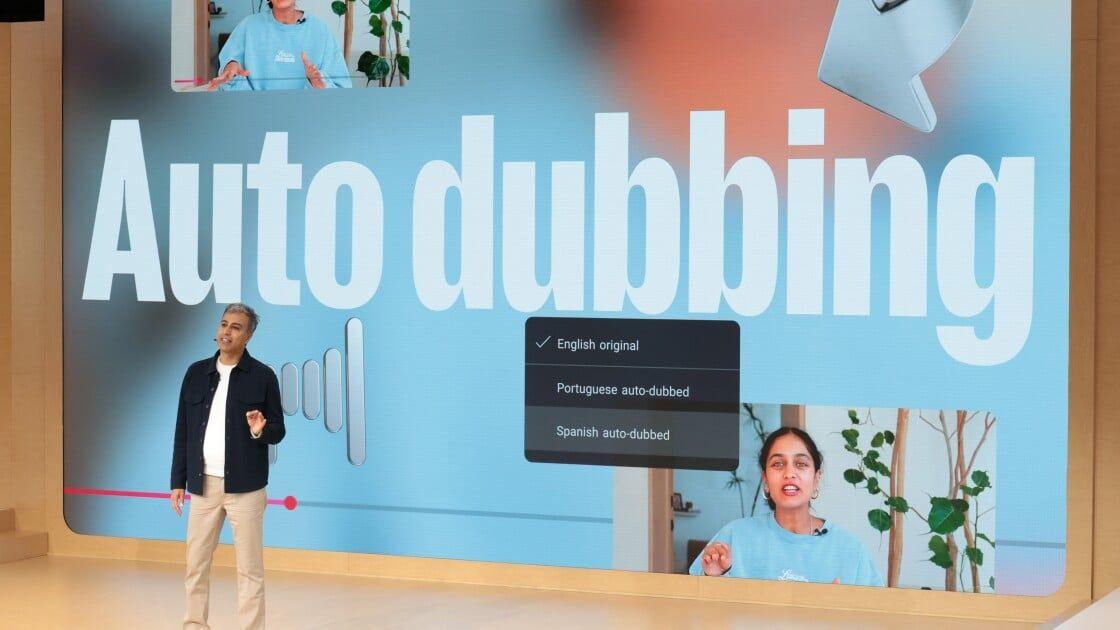YouTube Enhances AI-Dubbed Content Discovery on Android TV with New 'Dubbed' Tag
2 Sources
2 Sources
[1]
YouTube for Android TV gains a 'dubbed' tag for AI translated audio
Introduced a few months ago, the AI dubbing function is one of the few excellent uses of the technology to try and open videos to a wider global audience. To help with that YouTube on Android TV now has a "Dubbed" tag to help you see which videos have been translated using AI. Over the weekend we spotted a "Dubbed" tag appearing on some content when scrolling through the YouTube interface on Android TV and Google TV hardware. At the moment it looks like rare occurrence. Searching for the same video titled "100 Layer Sfogliatella" you might not see the tag. Instead, it will play with the auto-dubbed audio in your region. This is the default with non-native language videos based on your region. The new "Dubbed" tag is similar to the "Subtitles" tag you might also see when navigating the TV-based interface and is merely a grey text box under the video title, channel, and view count. There is a little person-speaking icon to indicate that the original audio is likely not in your native tongue. Annoyingly, this isn't easy to replicate, but we caught it in a grainy but visible image below: It's unclear quite how widely this new tag is available, but it will depend heavily on the creator. On desktop, this will appear when you open up the video and is visible under the title. On TVs, it's not possible to see this as the player controls are minimized as soon as you select the content - hence this differentiation. AI-dubbed audio is available to all YouTube creators, but it can be disabled during the upload process. When it works, the feature is very good, but like all things AI, it isn't perfect, and certain translations will lack nuance or specific regional variations. However, this might, at the very least, give you more videos to watch when kicking back and watching YouTube on your smart TV or Android TV box.
[2]
YouTube on Android TV now tells you which videos offer dubbed translations
YouTube on Android TV and Google TV has added a "Dubbed" tag to videos that have been translated with AI. YouTube has a vast library of videos to choose from, regardless of what your tastes may be. However, that pool of content is made a little smaller due to language barriers. In this respect, this has been one of the few areas where AI shines as YouTube's AI dubbing feature has helped to make videos more accessible to a global audience. Now it appears YouTube is making it easier to know which videos have recieved the dubbing treatment on smart TVs.
Share
Share
Copy Link
YouTube has introduced a 'Dubbed' tag for AI-translated audio on its Android TV app, making it easier for users to identify content that has been automatically translated into their language.

YouTube Introduces 'Dubbed' Tag for AI-Translated Content on Android TV
YouTube has taken a significant step in enhancing the discoverability of AI-dubbed content on its Android TV platform. The video-sharing giant has introduced a new 'Dubbed' tag, which appears alongside videos that have been automatically translated using artificial intelligence technology
1
.How the 'Dubbed' Tag Works
The 'Dubbed' tag is displayed as a grey text box under the video title, channel name, and view count on the Android TV and Google TV interfaces. It features a small icon of a person speaking, indicating that the original audio has likely been translated from a different language
1
.This new feature is similar to the existing 'Subtitles' tag and aims to help viewers quickly identify content that has been made accessible in their language through AI dubbing. However, the visibility of this tag may vary depending on factors such as the viewer's region and the creator's settings
1
.AI Dubbing: Expanding Global Access to Content
YouTube's AI dubbing function, introduced a few months ago, represents one of the more practical applications of AI technology in content distribution. By automatically translating audio into various languages, this feature aims to make a wider range of videos accessible to a global audience
2
.The AI dubbing feature is available to all YouTube creators, although they have the option to disable it during the upload process. While the technology has shown promising results, it's worth noting that, like all AI applications, it may sometimes lack nuance or struggle with specific regional variations in language
1
.Related Stories
Implications for Content Consumption
This development has significant implications for content consumption on smart TVs and Android TV boxes. By clearly identifying dubbed content, YouTube is making it easier for viewers to discover and enjoy videos that were previously inaccessible due to language barriers
2
.The 'Dubbed' tag is particularly useful on TV platforms where player controls are minimized upon content selection, making it difficult to identify translated content otherwise. This feature could potentially increase viewer engagement with a more diverse range of content, expanding the effective library of videos available to users in their preferred language
1
.As AI translation technology continues to improve, features like this could play a crucial role in breaking down language barriers in digital content consumption, fostering a more globally connected YouTube community.
References
Summarized by
Navi
[2]
Related Stories
YouTube Expands AI-Powered Auto-Dubbing Feature to Knowledge and Information Channels
11 Dec 2024•Technology

YouTube Expands AI-Powered Auto-Dubbing Feature for Global Content Accessibility
22 Nov 2024•Technology

YouTube's AI Lip-Sync Technology: Revolutionizing Auto-Dubbing for Global Content
14 Oct 2025•Technology

Recent Highlights
1
Google launches Gemini 3 Flash as default AI model, delivering speed with Pro-grade reasoning
Technology

2
OpenAI launches GPT Image 1.5 as AI image generator war with Google intensifies
Technology

3
OpenAI launches ChatGPT app store, opening doors for third-party developers to build AI-powered apps
Technology





